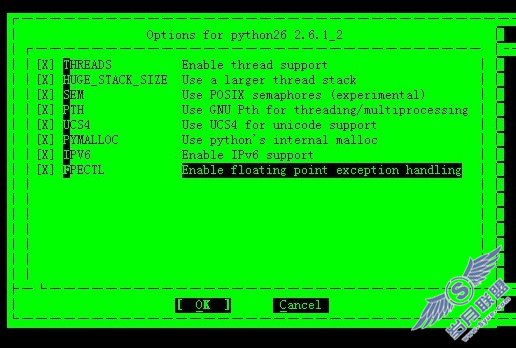Python的小技巧小知识
如何判断操作系统类型
import sys
print sys.platform
print sys.version
显示和修改python的Module搜索路径
>>> import sys
>>> print sys.path
[, /usr/lib/python23.zip, /usr/lib/python2.3, /usr/lib/python2.3/plat-linux2,
/usr/lib/python2.3/lib-tk, /usr/lib/python2.3/lib-dynload, /usr/local/lib/python2.3/site-packages,
/usr/lib/python2.3/site-packages]
>>> sys.path.append(/usr/lib/mypath)
>>> print sys.path
[, /usr/lib/python23.zip, /usr/lib/python2.3, /usr/lib/python2.3/plat-linux2,
/usr/lib/python2.3/lib-tk, /usr/lib/python2.3/lib-dynload, /usr/local/lib/python2.3/site-packages,
/usr/lib/python2.3/site-packages, /usr/lib/mypath]
把列表转换成字符串
>>> t=[a,b,c]
>>> print t
[a, b, c]
>>> import string
>>> print string.join(t)
a b c
运行系统程序
>>>import os
>>>os.system(ls) #用os.system()可执行系统命令
>>>exec "os.system(ls)" #用exec可执行字符串中的命令,两个命令的效果一样。
以上两个命令的输出都是直接显示在屏幕上,不能保存到变量中,如果我们要把输出保存起来,可用os.pope n()函数。
>>>cmd = /usr/bin/mkntpwd %s % password
>>>handler = os.popen(cmd,r)
>>>passwordString=handler.read() #passwordString为mkntpwd程序的输出结果
使用commands模块也可以获取程序的输出,它包含一些基于os.popen()的封装函数,使我们能更方便地获取运行系统命令和获取命令的输出,但该模块只在Unix系统下有效,不能用于Windows平台。
>>> import commands
>>> status,output = commands.getstatusoutput(ls -l)
>>> print output
总计 96564
-rw-r--r-- 1 root root 4459 2005-12-01 10:23 2005.sxw
-rw-r--r-- 1 root root 27511 2006-04-12 16:54 20060412_user.ods
-rw-r--r-- 1 root root 202258 2006-01-06 16:48 2006风景-1月.jpg
...
>>> print status
0
在Python2.4中引入一个新的模块叫subprocess,用于取代os.system、os.spawn*、os.popen*、popen2.*、commands.*。
编码转换
#!/usr/bin/python
#-*-coding:utf-8 -*-
a=u"测试"
b=a.encode(gb2312)
print a
print b
>>> a = 中国
>>> a.encode(gb2312)
Traceback (most recent call last):
File "<stdin>", line 1, in ?
File "/usr/lib/python2.3/encodings/gb2312.py", line 21, in encode
if c < uu0080:
UnicodeDecodeError: ascii codec cant decode byte 0xe4 in position 0: ordinal not in range(128)
>>> unicode(a,utf-8)
uu4e2du56fd
>>> b = unicode(a,utf-8)
>>> print b
中国
>>> c = b.encode(gb2312)
>>> c
xd6xd0xb9xfa
>>> print c # c是gb2312字符集的‘中国’,在我的utf-8系统中显示乱码是正常的。
?
>>>
PS:我的shell环境是utf-8。
交换两个变量
>>> a,b = 1,2
>>> a,b
(1, 2)
>>> a,b = b,a
>>> a,b
(2, 1)
>>> a
2
>>> b
1
测试数据类型
>>> a=123
>>> b=test
>>> a
123
>>> b
test
>>> isinstance(a,int)
True
>>> isinstance(a,str)
False
>>> isinstance(b,int)
False
>>> isinstance(b,str)
True
用in判断是否包含子字符串
>>> a=this is my test
>>> is in a
True
>>> mm in a
False
__iter__迭代器
>>> a = "iterator"
>>> t = iter(a)
>>> t.next()
i
>>> t.next()
t
>>> t.next()
e
>>> t.next()
r
>>> t.next()
a
>>> t.next()
t
>>> t.next()
o
>>> t.next()
r
>>> t.next()
Traceback (most recent call last):
File "<stdin>", line 1, in ?
StopIteration
自已写一个迭代器类
>>> class reverse:
... def __init__(self,data):
... self.data=data
... self.index=len(data)
... def __iter__(self):
... return self
... def next(self):
... if self.index == 0:
... raise StopIteration
... self.index = self.index - 1
... return self.data[self.index]
...
>>> for char in reverse(iterator):
... print char
...
r
o
t
a
r
e
t
i
>>>
通过getattr可以得到一个在运行时才知道具体函数名的对象的引用,能增强我们程序的灵活性。
>>> li=[a,b]
>>> getattr(li,append)
>>> getattr(li,append)(c) #相当于li.append(c)
>>> li
[a, b, c]
>>> handler=getattr(li,append,None)
>>> handler
<built-in method append of list object at 0xb7d4a52c>
>>> handler(cc) #相当于li.append(cc)
>>> li
[a,b,c,cc]
>>>result = handler(bb)
>>>li
[a,b,c,cc,bb]
>>>print result
None
编程示例:
import statsout
def output(data, format="text"):
output_function = getattr(statsout, "output_%s" % format)
return output_function(data)
以上代码表示,output函数接收一个data参数和format参数,根据format参数的值,从statsout模块中取出output_text函数运行,data参数通过output_function(data)传递给了statsout模块中的output_text函数。format取不同值可从statsout模块中取出不同的函数运行(output_xxxx)。也就是说我们要运行的函数是在程序运行后才确定的。这样我们可把不同的函数以output_xxx形式命名放在statout模块中,通过以上程序可动态调用各种函数。
hasattr用于确定一个对象是否具有某个属性。
语法:
hasattr(object, name) -> bool
判断object中是否有name属性,返回一个布尔值。
拆分序列
>>> a=[c for c in abcdefg]
>>> a
[a, b, c, d, e, f, g]
>>>
按if条件拆分序列
>>> a=[c for c in 123456 if int(c)<3] 如果if的条件为真,则执行for循环
>>> a
[1, 2]
>>> a=[c for c in 123456 if int(c)>3] 如果if的条件为假,则不执行for循环
>>> a
[4, 5, 6]
